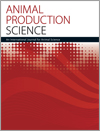
Animal Production Science
Volume 62 Number 13 2022
AN21230Cattle welfare aspects of production systems in the tropics
 , Carlos S. Galina, Mariana Geffroy, Jens Jung, Rebecka Westin and Charlotte Berg
, Carlos S. Galina, Mariana Geffroy, Jens Jung, Rebecka Westin and Charlotte Berg
Animal welfare and sustainability are increasingly important to modern society. Better efficiency of existing farms is key to meeting the growing demand without ignoring societal concerns. Better animal welfare could improve tropical animal production in terms of volume and consumer acceptance.
AN21230 Abstract | AN21230 Full Text | AN21230PDF (1.6 MB) Open Access Article
North Australian cattle producers with Brahman herds considering crossbreeding with a tropically adapted Bos taurus breed to produce animals with improved meat quality would want to know how females retained for breeding are likely to perform under harsh northern conditions. This study compared the performance of four year groups of F1 Senepol × Brahman and Brahman females, and found that performance was better in F1 Senepol × Brahman heifers, and similar in mature cows.
AN22074Conception rate according to antral follicle count and oestrus expression in Nelore cows submitted to timed artificial insemination
 , Fábio Morotti
, Fábio Morotti  and Marcelo Marcondes Seneda
and Marcelo Marcondes Seneda 
Fertility is a complex aspect in cattle: the aspects of ovarian physiology and oestrus behaviour may influence reproductive technology. We evaluated influence of the number of growing follicles in the ovary and oestrus expression on the pregnancy rate in beef cattle. We found a positive influence on the antral follicle count and demonstration of oestrus in the total number of pregnancies. We believe those results may improve the reproductive efficiency of bovine females.
AN21393Supplementation of reduced protein diets with l -arginine and l -citrulline for broilers challenged with subclinical necrotic enteritis. 1. Growth, carcass yield, and intestinal lesion scores
 , Nishchal K. Sharma, Ali Daneshmand, Alip Kumar, Emma J. Bradbury, Shu-Biao Wu
, Nishchal K. Sharma, Ali Daneshmand, Alip Kumar, Emma J. Bradbury, Shu-Biao Wu  and Robert A. Swick
and Robert A. Swick 
Economic losses from necrotic enteritis have increased in the broiler industry with the removal of in-feed antibiotic growth promoters. The results of this study showed that feeding reduced-protein diets supplemented with citrulline was beneficial in promoting gut health and recovery from the necrotic enteritis challenge. This information may help control and/or mitigate the effects of necrotic enteritis in antibiotic growth promoter-free poultry production.
AN21393 Abstract | AN21393 Full Text | AN21393PDF (1.6 MB) Open Access Article
AN21394Supplementation of reduced protein diets with l -arginine and l -citrulline for broilers challenged with subclinical necrotic enteritis. 2. Intestinal permeability, microbiota, and short-chain fatty acid production
 , Nishchal K. Sharma, Reza Barekatain, Sarbast K. Kheravii, Emma J. Bradbury, Shu-Biao Wu
, Nishchal K. Sharma, Reza Barekatain, Sarbast K. Kheravii, Emma J. Bradbury, Shu-Biao Wu  and Robert A. Swick
and Robert A. Swick 
Necrotic enteritis has been considered a major threat in broiler chicken production. The results of this study showed that feeding reduced protein diets supported gut health of necrotic enteritis-challenged birds by reducing Clostridium perfringens in the caeca, and increasing total short-chain fatty acid concentrations in the ileum compared with standard protein diets. Also, in-part replacement of arginine by citrulline in reduced protein diets had beneficial effects on gut health during necrotic enteritis challenge.
AN21394 Abstract | AN21394 Full Text | AN21394PDF (2.8 MB) Open Access Article
AN21395Supplementation of reduced protein diets with l -arginine and l -citrulline for broilers challenged with subclinical necrotic enteritis. 3. Immunological parameters and gene expression
 , Nishchal K. Sharma, Sarbast K. Kheravii, Emma J. Bradbury, Shu-Biao Wu
, Nishchal K. Sharma, Sarbast K. Kheravii, Emma J. Bradbury, Shu-Biao Wu  and Robert A. Swick
and Robert A. Swick 
Necrotic enteritis has been estimated to cause losses of US$6 billion annually to the global broiler industry. Feeding reduced protein diets may alleviate a decline in growth during subclinical necrotic enteritis by increasing gene expression of tight junction proteins compared with the standard protein diets. However, if birds are infected with a more severe form of the disease, additional supplementations of minerals and crystalline amino acids to the reduced protein diets are necessary to support the host immune response.
AN21395 Abstract | AN21395 Full Text | AN21395PDF (1.9 MB) Open Access Article
Environment and geographical locations could influence the pattern of plant wax profiles, and hence there is a need to document location-specific information. The huge variability observed among key forage species in this study in terms of the patterns of plant wax profiles will make them suitable markers for estimating diet composition and determining diet digestibility in grazing animal.
Livestock guardian dogs are increasingly important in preventing livestock predation around the world, including in protecting hens for free-range egg production. Using GPS tracking and cameras, we identified behavioural responses of four dogs to potential threat of fox incursion. Three dogs showed a strong bond with their chickens and spent more time around the chicken huts at night, increasing their activity on nights where they were exposed to fox cues. The fourth dog preferred spending time around people.
AN21229 Abstract | AN21229 Full Text | AN21229PDF (4.2 MB) Open Access Article



